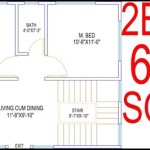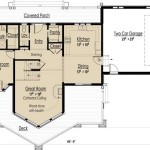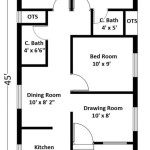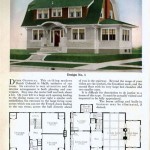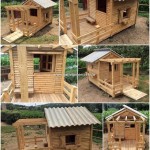Narrow house floor plans, characterized by their elongated and compact design, offer a unique solution for maximizing space in constrained urban or suburban areas. These plans typically feature a linear layout with rooms arranged along a central corridor. One notable example is the “Narrow House” in London, designed by architect John Pawson, which utilizes clever space-saving techniques to create a comfortable and functional living space within its narrow confines.
The primary advantage of narrow house floor plans lies in their ability to optimize space utilization. By maximizing every square foot, they provide an efficient and affordable way to create livable homes on narrow or awkwardly shaped lots. They are particularly well-suited for urban environments where land is at a premium and for homeowners seeking modern and minimalist designs.
In the following sections, we will explore the key considerations, advantages, and challenges associated with narrow house floor plans, providing insights and practical tips for homeowners and architects looking to implement this innovative housing design.
Consider these key points when planning a narrow house floor plan:
- Maximize natural light
- Utilize vertical space
- Create open sightlines
- Incorporate multi-functional spaces
- Prioritize storage solutions
- Emphasize flow and circulation
- Consider privacy and noise control
- Explore innovative materials and finishes
- Pay attention to proportions
- Seek professional guidance
By carefully addressing these aspects, homeowners and architects can create functional, comfortable, and aesthetically pleasing narrow house floor plans.
Maximize natural light
In narrow house floor plans, maximizing natural light is crucial for creating a bright and welcoming living space. Large windows and skylights should be strategically placed along the length of the house to allow ample daylight to penetrate the interior. Clerestory windows, positioned high on the walls, can also be effective in bringing in light while maintaining privacy.
Translucent or transparent materials, such as glass or polycarbonate, can be incorporated into interior walls or partitions to allow light to filter through and create a sense of spaciousness. Light-colored walls and finishes reflect and distribute natural light more effectively, making the space feel larger and brighter.
Courtyards or light wells can be introduced to bring natural light into the center of the house, especially in areas that lack direct access to exterior windows. These open spaces not only provide a source of light but also create a visual connection to the outdoors and enhance ventilation.
By carefully considering the placement of windows, skylights, and other light-enhancing features, homeowners can optimize natural light in their narrow house floor plans, reducing the need for artificial lighting and creating a more comfortable and energy-efficient living environment.
Utilize vertical space
In narrow house floor plans, maximizing vertical space is essential for creating a sense of spaciousness and accommodating all necessary functions. By utilizing the height of the house, homeowners and architects can create additional living areas, storage spaces, and functional zones without increasing the footprint of the building.
One effective way to utilize vertical space is to incorporate lofts or mezzanines. These elevated platforms can be used for a variety of purposes, such as creating a sleeping area, a home office, or a cozy reading nook. Lofts and mezzanines also help to create visual interest and add a unique architectural element to the narrow house design.
Another way to maximize vertical space is to install built-in storage solutions, such as floor-to-ceiling shelves, cabinets, and drawers. These built-ins not only provide ample storage but also create a streamlined and organized look. Vertical storage units can be incorporated into walls, under stairs, or in awkward spaces that would otherwise go unused.
Additionally, homeowners can utilize vertical space by installing tall windows and doors. These elements not only allow for more natural light to enter the house but also create the illusion of height and spaciousness. Tall windows and doors can be combined with curtains or blinds that can be adjusted to control light and privacy.
By carefully considering how to utilize vertical space, homeowners and architects can create functional and comfortable narrow house floor plans that make the most of the available space and create a sense of spaciousness and grandeur.
Create open sightlines
In narrow house floor plans, creating open sightlines is crucial for enhancing the sense of spaciousness and allowing natural light to penetrate deeper into the house. Open sightlines refer to unobstructed views through the house, both horizontally and vertically. By minimizing visual barriers and creating a seamless flow of space, homeowners can make their narrow houses feel larger and more inviting.
One effective way to create open sightlines is to use large windows and doors. By maximizing the glazed areas, homeowners can allow more natural light to enter the house and create a connection between the interior and exterior spaces. Floor-to-ceiling windows and sliding glass doors are particularly effective in creating open sightlines and blurring the boundaries between inside and outside.
Another way to create open sightlines is to minimize the use of walls and partitions. Open-plan living areas, where multiple functions such as living, dining, and cooking are combined into one large space, promote a sense of spaciousness and allow for easy flow of movement. Arches, columns, or beams can be used to define different areas within the open plan while maintaining open sightlines.
Additionally, homeowners can use transparent or translucent materials, such as glass or polycarbonate, to create partitions or room dividers. These materials allow light to pass through, preserving the sense of openness while still providing some level of separation between spaces. Skylights and clerestory windows can also be effective in creating open sightlines by bringing natural light into the center of the house and reducing the reliance on artificial lighting.
By carefully considering how to create open sightlines, homeowners and architects can design narrow house floor plans that feel spacious,, and inviting. Open sightlines not only enhance the aesthetic appeal of the house but also contribute to the overall comfort and well-being of its occupants.
Incorporate multi-functional spaces
Incorporating multi-functional spaces is a clever way to maximize space and create adaptable living areas in narrow house floor plans. By designing rooms that can serve multiple purposes, homeowners can make the most of every square foot and create a flexible and dynamic living environment.
- Living room/dining room combination: Combining the living room and dining room into one open-plan space is a popular and effective way to create a more spacious and versatile area. This layout is ideal for entertaining guests, hosting family gatherings, or simply creating a larger and more comfortable living space.
- Home office/guest room: A spare room can be transformed into a multi-functional space that serves as both a home office and a guest room. By incorporating a sofa bed or a Murphy bed, homeowners can create a comfortable and private space for guests while also having a dedicated workspace.
- Kitchen/breakfast nook: Extending the kitchen to include a breakfast nook is a great way to create an informal dining area and maximize the use of space. The breakfast nook can also be used as a casual workspace or a homework station for children.
- Mudroom/laundry room: Combining the mudroom and laundry room into one space creates a convenient and efficient area for managing shoes, coats, and laundry. This layout helps to keep the house clean and organized, and it also provides a dedicated space for household chores.
By incorporating multi-functional spaces into their narrow house floor plans, homeowners can create flexible and adaptable living environments that meet their specific needs and lifestyles. Multi-functional spaces not only save space but also promote a sense of openness and flow throughout the house.
Prioritize storage solutions
In narrow house floor plans, maximizing storage space is crucial for maintaining a clutter-free and organized living environment. By incorporating well-planned storage solutions, homeowners can utilize every nook and cranny to keep their belongings neatly tucked away and create a sense of spaciousness throughout the house.
Built-in storage: Built-in storage solutions, such as floor-to-ceiling shelves, cabinets, and drawers, are a highly effective way to maximize storage space in narrow houses. These built-ins can be customized to fit specific spaces and needs, providing ample storage for items of all shapes and sizes. They also create a streamlined and cohesive look, making the house appear more spacious and organized.
Multi-purpose furniture: Multi-purpose furniture pieces that combine storage with other functions are a smart choice for narrow houses. Ottomans with built-in storage can serve as both seating and a place to store blankets, pillows, or toys. Beds with drawers or built-in headboards with shelves provide additional storage without taking up extra floor space. By choosing furniture that doubles as storage, homeowners can maximize functionality and save space.
Vertical storage: Utilizing vertical space for storage is essential in narrow houses. Wall-mounted shelves, hanging organizers, and stackable bins can be used to store items off the floor, making the most of the available height. Vertical storage solutions are particularly useful in areas like bathrooms, kitchens, and laundry rooms, where space is often limited. By storing items vertically, homeowners can keep their belongings organized and easily accessible while minimizing clutter.
Hidden storage: Incorporating hidden storage spaces into narrow house floor plans is a clever way to keep clutter out of sight. Under-stair storage, pull-out drawers in kitchen islands, and built-in benches with hidden compartments can provide discreet storage solutions without compromising the aesthetics of the house. Hidden storage is particularly useful for storing seasonal items, bulky appliances, or other items that are not frequently used.
Emphasize flow and circulation
In narrow house floor plans, emphasizing flow and circulation is crucial for creating a comfortable and functional living space. By carefully planning the arrangement of rooms and spaces, homeowners and architects can ensure that movement throughout the house is smooth, efficient, and intuitive. This not only enhances the overall livability of the house but also contributes to a sense of spaciousness and well-being.
- Create a central axis or circulation path: Establishing a central axis or circulation path through the house provides a clear and defined flow of movement. This path should connect the main areas of the house, such as the living room, kitchen, and bedrooms, and should allow for easy access to all spaces.
- Minimize dead-end spaces: Dead-end spaces, such as long hallways or isolated rooms, can disrupt the flow of circulation and create a sense of clutter. When planning the layout of a narrow house, it is important to minimize dead-end spaces and ensure that all areas of the house are easily accessible.
- Use open-plan layouts: Open-plan layouts, where multiple functions are combined into one large space, can promote a sense of flow and spaciousness. By eliminating unnecessary walls and partitions, homeowners can create a more fluid and interconnected living environment.
- Incorporate visual cues: Visual cues, such as changes in flooring or ceiling height, can help to guide movement and create a sense of flow throughout the house. These cues can also be used to define different areas within the open-plan layout and create a more dynamic and visually interesting space.
By carefully considering how to emphasize flow and circulation, homeowners and architects can create narrow house floor plans that are not only functional and comfortable but also visually appealing and enjoyable to live in.
Consider privacy and noise control
In narrow house floor plans, privacy and noise control are important considerations for creating a comfortable and peaceful living environment. By carefully planning the layout of rooms and spaces, and incorporating appropriate design elements, homeowners and architects can ensure that privacy and noise levels are well-managed throughout the house.
- Create separate zones for private and public spaces: Clearly defining separate zones for private and public spaces is essential for maintaining privacy in narrow house floor plans. Private spaces, such as bedrooms and bathrooms, should be located away from high-traffic areas and public spaces, such as the living room and kitchen. This separation helps to create a sense of privacy and tranquility in the private areas of the house.
- Incorporate soundproofing materials: Soundproofing materials, such as acoustic insulation and sound-absorbing panels, can be used to reduce noise levels and improve privacy between rooms. These materials can be installed in walls, ceilings, and floors to minimize the transmission of sound between different areas of the house.
- Use noise-reducing fixtures and appliances: Choosing noise-reducing fixtures and appliances can also help to control noise levels in narrow house floor plans. For example, installing low-noise exhaust fans in bathrooms and kitchens, and choosing quiet dishwashers and washing machines, can minimize noise pollution and create a more peaceful living environment.
- Consider the placement of windows and doors: The placement of windows and doors can impact both privacy and noise control in narrow house floor plans. Windows and doors that face busy streets or noisy neighbors should be minimized, or fitted with soundproofing glass and curtains, to reduce noise levels inside the house. Conversely, windows and doors that face quieter areas, such as gardens or courtyards, can provide natural light and ventilation while maintaining privacy.
By carefully considering privacy and noise control measures, homeowners and architects can create narrow house floor plans that provide a comfortable, peaceful, and private living environment for occupants.
Explore innovative materials and finishes
In narrow house floor plans, innovative materials and finishes can be used to enhance functionality, create visual interest, and maximize the sense of space. By embracing cutting-edge materials and design techniques, homeowners and architects can transform narrow houses into unique and stylish living environments.
Utilize reflective surfaces: Reflective surfaces, such as mirrors, polished metal, and glossy tiles, can create the illusion of space and depth in narrow house floor plans. By reflecting light and expanding the visual field, reflective surfaces can make narrow spaces feel larger and more open. Mirrors can be strategically placed opposite windows to reflect natural light and create a sense of continuity between the interior and exterior spaces.
Incorporate natural materials: Natural materials, such as wood, stone, and bamboo, bring warmth, texture, and a sense of organic connection to narrow house floor plans. These materials can be used for flooring, walls, and ceilings to create a cozy and inviting atmosphere. Natural materials are also durable and sustainable, making them a smart choice for both aesthetic and practical reasons.
Experiment with bold colors and patterns: Bold colors and patterns can be used to create visual interest and define different areas within narrow house floor plans. Accent walls, feature tiles, and patterned rugs can add a touch of drama and personality to the space. When used in moderation, bold colors and patterns can help to break up the monotony of long, narrow spaces and create a sense of visual rhythm.
Incorporate smart home technology: Smart home technology can be seamlessly integrated into narrow house floor plans to enhance functionality and convenience. Automated lighting systems, motorized blinds, and smart appliances can be controlled remotely using a smartphone or voice assistant, making it easier to manage the home environment and create a more comfortable and efficient living space.
By exploring innovative materials and finishes, homeowners and architects can create narrow house floor plans that are not only functional and comfortable but also visually appealing and unique. These innovative elements can transform narrow spaces into stylish and inviting living environments that maximize space, create visual interest, and enhance the overall quality of life.
Pay attention to proportions
When designing narrow house floor plans, paying careful attention to proportions is crucial for creating a visually balanced and harmonious living space. The proportions of a room refer to the relationship between its length, width, and height. Getting the proportions right can make a narrow room feel more spacious and comfortable, while incorrect proportions can make it feel cramped and uncomfortable.
One important aspect of proportions in narrow house floor plans is maintaining a balance between length and width. Ideally, a narrow room should have a length-to-width ratio of approximately 2:1 or 3:2. This ratio creates a sense of balance and prevents the room from feeling too long and narrow or too wide and short. If the room is too long, it can feel like a corridor, while if it is too wide, it can feel like a box.
Another important aspect of proportions is the relationship between the height of the room and its length and width. In general, a narrow room should have a height that is at least half of its width. This proportion creates a sense of spaciousness and prevents the room from feeling. If the room is too low, it can feel like a cave, while if it is too high, it can feel like a warehouse.
Finally, it is important to consider the proportions of individual elements within the room, such as windows, doors, and furniture. These elements should be in proportion to the overall size of the room and to each other. For example, a large window in a small room can make the room feel even smaller, while a small window in a large room can make the room feel even larger. By carefully considering the proportions of all elements in the room, homeowners and architects can create a narrow house floor plan that is visually balanced, harmonious, and comfortable to live in.
In summary, paying attention to proportions is essential for creating successful narrow house floor plans. By maintaining a balance between length, width, and height, and by carefully considering the proportions of individual elements within the room, homeowners and architects can create narrow spaces that feel spacious, comfortable, and visually appealing.
Seek professional guidance
When it comes to designing and building narrow house floor plans, seeking professional guidance from an experienced architect or designer is highly recommended. Here’s why:
Expertise and knowledge: Architects and designers have the necessary expertise and knowledge to create functional and aesthetically pleasing narrow house floor plans. They are familiar with the challenges and opportunities associated with designing narrow spaces and can provide creative solutions to maximize space and create a comfortable living environment.
Building code compliance: Professional architects and designers are well-versed in building codes and regulations, ensuring that your narrow house floor plan meets all safety and structural requirements. They can guide you through the permitting process and help you avoid costly mistakes or delays during construction.
Space optimization: Architects and designers can help you optimize the use of space in your narrow house floor plan. They can create innovative layouts, incorporate multi-functional spaces, and utilize vertical space to maximize storage and living areas without compromising comfort or functionality.
Personalized design: Professional guidance allows you to collaborate with an architect or designer to create a narrow house floor plan that meets your specific needs, preferences, and lifestyle. They can incorporate your ideas, consider your budget, and design a home that truly reflects your unique style and personality.
Investing in professional guidance for your narrow house floor plan is a worthwhile decision that can save you time, money, and stress in the long run. A skilled architect or designer will help you create a functional, comfortable, and visually appealing home that meets your specific requirements and enhances your quality of life.










Related Posts

